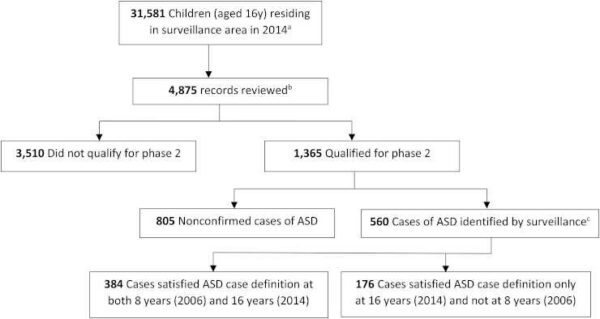According to research from Rutgers, approximately one-fourth of 16-year-olds with autism spectrum disorder (ASD) do not have a formal diagnosis. The study employed a technique known as active multiple-source surveillance to generate what its authors consider to be the most accurate data ever collected on the prevalence of ASD among adolescents in our region.
“We think this is the largest ever study of ASD in this age group, and we hope it helps schools, health care providers and others with information that leads to better understanding and services,”
said lead author Walter Zahorodny, an associate professor at Rutgers New Jersey Medical School.
ASD and ADHD

The researchers found that, overall, 1.77 percent of 16-year-olds in northeastern New Jersey have autism spectrum disorder, but the condition affects males more than females, whites more than Blacks or Hispanics, and high-income adolescents more than low-income peers.
Researchers also discovered that one in four adolescents with autism spectrum disorder are undiagnosed and that three in five adolescents with ASD have one or more neuropsychiatric conditions, most commonly attention deficit hyperactivity disorder (ADHD).
Researchers reviewed school and health records for 4,875 of the 31,581 16-year-olds who lived in four northern New Jersey counties in 2014. That initial review identified 1,365 records that merited comprehensive evaluation and analysis, which, in turn, confirmed 560.
Of those, 384 had been identified through monitoring when the cohort was 8 years old, and another 176 individuals met the diagnostic criteria for ASD at the age of 16.
Autism spectrum disorder was found in 2.89 percent of adolescent males compared to 0.62 percent of females.
Race and Socioeconomics
ASD was twice as likely in adolescents from high-income homes as in those from low-income families. The diagnosis of ASD varied greatly by race and socioeconomic position.
Autism spectrum disorder was 50 percent more prevalent in white adolescents than in Black and Hispanic peers. (There weren’t enough Asian teens in the cohort to compare rates.)
“This confirms what other studies have found about the relative occurrence of autism by sex, race and socioeconomic status in childhood, and it almost certainly reflects true incidence patterns rather than better diagnosis rates among groups that get more frequent and better medical care. Our study didn’t examine why prevalence rates vary, but other studies suggest a complex interaction of genes and environment,”
Zahorodny said.
Undiagnosed Autism Cases
Perhaps the most significant findings of the study are the high proportion of adolescents with ASD who also have other neuropsychiatric disorders and the identification of a sizable number of undiagnosed autism cases, especially among adolescents with mild forms of impairment.
The finding that many individuals go undiagnosed—and that many adolescents who could benefit from support never receive it—suggests that schools and healthcare providers could improve their tools for detecting ASD. Given that the majority of autism spectrum disorder sufferers also have another neuropsychiatric condition, it is likely that this group will have more complex needs and will necessitate more extensive planning and interventions.
Although this research team has now studied the same population twice, Zahorodny hopes that this study will not be the last.
We would love to continue studying this same cohort going forward because we know so much less about autism in adulthood,
Zahorodny said.
Continuing to follow this group of over 500 people could significantly add to the understanding of autism spectrum disorder and how it manifests in adulthood, eventually leading to the identification of interventions that maximize well-being.
Abstract
Purpose: Almost all epidemiologic studies estimating autism spectrum disorder (ASD) prevalence have focused on school-age children. This study provides the first population-based data on the prevalence and expression of ASD among adolescents in a large US metropolitan region.
Methods: Active multiple source ASD surveillance of adolescents aged 16-years was conducted according to the Autism and Developmental Disabilities Monitoring (ADDM) Network method in a four-county New Jersey metropolitan region. Prevalence estimates are provided, characteristics are described and comparison of the distribution and characteristics of ASD is offered for this cohort, at 8 and 16-years.
Results: ASD prevalence was 17.7 per 1000 (95% CI: 16.3–19.2)]. One-in-55 males and one in 172 females were identified with ASD. High-SES was positively associated with ASD and White adolescents had higher ASD prevalence (22.2 per 1000) than Hispanic adolescents (13.1 per 1000). One in four study-confirmed individuals with ASD did not have an ASD diagnosis. A majority of ASD adolescents (58.8%) had a co-occurring neuropsychiatric disorder. White and High-SES individuals had greater likelihood of co-occurring disorder. The demographic distribution and functional profile of ASD was similar in this cohort at 8 and 16-years.
Conclusion: Approximately one-in-55 adolescents in our area had ASD, in 2014, and one-in-4 16-year-olds with ASD was not diagnosed. A majority (3-in-5) of the adolescents with ASD had a co-occurring neuropsychiatric disorder. ASD under-identification and the high frequency of co-disorders in adolescents with ASD pose significant challenges to care and support.
Reference:
- Zahorodny, W., Shenouda, J., Sidwell, K. et al. Prevalence and Characteristics of Adolescents with Autism Spectrum Disorder in the New York-New Jersey Metropolitan Area. J Autism Dev Disord (2023). doi: 10.1007/s10803-023-06058-8
